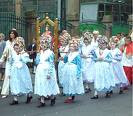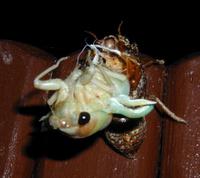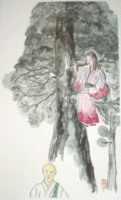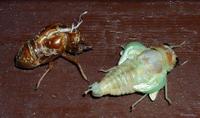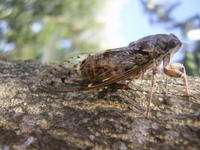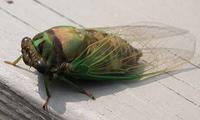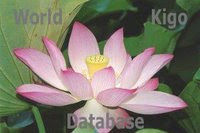:::::::::::::::::::::::::::::::::::::::::::::::::::::::::::::::::::::::::::::::::::::::::::::::::::::
Cold wave (kanpa, kampa)
***** Location: Japan, worldwide
***** Season: All Winter and see below
***** Category:Heavens
*****************************
Explanation
cold wave, cold spell, kanpa, kampa 寒波
cold wave coming, kanpa kuru 寒波来る
first (cold) of the winter, fuyu ichiban 冬一番

http://www.tbs.co.jp/weather/pressure-j.html
The cold waves coming down from Siberia are a common feature in the Japanese winter. In 2006, warm weather on the side of the Sea of Ohotsk (Ohotsuku オホツク)was about plus 18 degrees warm, and on the side of the Japanese Sea in went down to minus 30 degrees centigrade in the higher air masses!
This sudden cooling caused widespread stroms all over Japan. In Hokkaido, there was a severe tornado, killing many people.
Read more about it here in my local news from
/November 7, 2006 in Japan
The ususally do not last very long, but bring snow and storm, especially to the Sea of Japan side of the islands.
Gabi Greve
:::::::::::::::::::::::::::::::::::::::::::::::::::::::::::::::::::::::::::::::::::::::::::::::::::::
In other languages, there are expressions with COLD which do not relate to the winter feeling of coldness, the Japanese kanji for COLD : SAMUI, KAN 寒.
For kigo with the use of COLD ( KAN) in other seasons, see below.
Sometimes it should be clear from the context, like COLD COFFEE, sometimes you better check the World Kigo Database again.
Cold can be your physical feeling when you are out there, in various degrees of discomfort for your body. Or it can be the feeling of how it must be outside, by just looking out of the window.
cold morning, cold evening
(samuki asa, asazamu / samuki yoru, yosamu) on the other hand are expressions used for this feeling in autumn, when we feel the change of the seasons coming.
Morning, daytime, evening, night and KIGO
:::::::::::::::::::::::::::::::::::::::::::::::::::::::::::::::::::::::::::::::::::::::::::::::::::::
More kigo which relate to winter weather cold
(kan 寒) include:
cold season starts, kan no iri, 寒の入 (かんのいり)
..... kan iri 寒入り(かんいり)
"little cold", minor cold, small chill, shokan 小寒 (しょうかん)
5 or 6 Jan
"big cold", major cold, big chill, daikan 大寒 (だいかん)
20 or 21 Jan
two of the 24 seasons of the lunar calendar .
in the middle of the cold season,
kan no uchi 寒の内 (かんのうち)
..... cold, kan 寒(かん), kanchuu 寒中(かんちゅう)
..... kan shiroo 寒四郎(かんしろう), kan ku 寒九(かんく)
extreme cold, genkan 厳寒 (げんかん)
..... gokukan 極寒(ごくかん)
..... kokkan 酷寒(こっかん)
cold hard to bear, kan kibishi 寒きびし(かんきびし)
extreme winter, atrocious winter, gentoo 厳冬(げんとう)
Winter Dog Days, kan doyoo 寒土用 (かんどよう)
........................................
feeling cold, samushi 寒し (さむし)
..... samusa, 寒さ
cold air, kanki 寒気(かんき)
strong coldness, kan-i, kani 寒威(かんい)
freezing cold, kanrei 寒冷(かんれい)
suffering in the cold, kanku 寒苦(かんく)
cold winter evening, kanbo 寒暮(かんぼ)
cold winter night, kanya 寒夜(かんや)
cold winter morning, kangyoo 寒暁(かんぎょう)
..... fuyu akatsuki 冬暁(ふゆあかつき)
moon in the cold, kangetsu 寒月(かんげつ)
river in the cold, kankoo 寒江(かんこう)、寒巖(かんがん)
rock in the cold, kangan 寒巖(かんがん)
sound of the cold watch, kantaku 寒柝(かんたく)
a sort of village patrol using sticks to make a sound, to make sure there are no fires or other dangers during a cold winter night.
..... kansui 寒翠(かんすい)
..... kanteki 寒笛(かんてき)flute, whistle in the cold
:::::::::::::::::::::::::::::::::::::::::::::::::::::::::::::::::::::::::::::::::::::::::::::::::::::
cold feeling (of people, things etc.),
tsumetashi 冷し (つめたし)
..... sokobie 底冷(そこびえ)penetrating cold
("cold on the floor") chilled to the bone
something gets cold, hiyu 冷ゆ (ひゆ)
.................................................................................
kigo for late winter
shibareru しばれる severe cold
..... shibare しばれ、凍れ(しばれ)
shibaruru しばるる、
karashibare からしばれ
This is a word in the dialect of Northern Japan and Hokkaido, when the winter days get really cold and freezing, even during the daytime.
*****************************
Worldwide use
*****************************
Things found on the way
*****************************
HAIKU
first cold wave -
your unexpected freeze
makes me shiver
Gabi Greve, November 7, 2006
xxxxxxxxxxxxxxxxxxxxxxxxxxxxx
shelters open
blankets spread
under downcast eyes
jurassic roaches
at switch of light
subliminal flash
Doris Kasson: Cold Wave
Shiki Archives, 4 Feb 1996
xxxxxxxxxxxxxxxxxxxxxxxxxxxxx
first cold wave-
the jacket you won't
wear again
first cold wave-
the smell of mothballs
everywhere
Robert Mestre - Dhammasaavaka
Simply Haiku, Nov 13, 2003
*****************************
Related words
***** Winter (fuyu)
***** ..... Cold Dew (kanro) Japan
:::::::::::::::::::::::::::::::::::::::::::::::::::::::::::::::::::::::::::::::::::::::::::::::::::::
COLD kigo for early spring
cold in spring, haru samu 春寒 はるさむ
..... haru samushi 春寒し(はるさむし)
..... samuki haru 寒き春(さむきはる)
..... shunkan 春寒(しゅんかん)
cold wind in spring ryooshoo 料峭(りょうしょう)
still feeling cold, remaining cold, yokan 余寒 (よかん)
lingering cold, nokoru samusa 残る寒さ(のこるさむさ)
end of the cold season, "cold breaks",
kan ake 寒明 (かんあけ)
..... kan akeru 寒明ける(かんあける)
a break in the cold, kan no ake 寒の明 (かんのあけ)
cold season is ending, kan owaru 寒終る(かんおわる)
cold season has passed, kan sugiru 寒過ぎる(かんすぎる)
cold season is coming back,
kan kaeru 寒返る(かんかえる)
..... kan modori 寒もどり(かんもどり)
:::::::::::::::::::::::::::::::::::::::::::::::::::::::::::::::::::::::::::::::::::::::::::::::::::::
COLD kigo for late autumn
Cold in autumn, aki samu 秋寒 (あきさむ)
..... aki samushi 秋寒し(あきさむし)、
..... aki kosamu 秋小寒(あきこさむ)
feeling a little cold in autumn, sozoro samu
そぞろ寒 (そぞろさむ)
..... sozoro ni samushi そぞろに寒し(そぞろにさむし)
..... suzuru samu すずろ寒(すずろさむ)
..... uso samu うそ寒 (うそさむ)
..... usu samu 薄寒(うすさむ), usura samu うすら寒(うすらさむ)
..... karigane samuki かりがね寒き (かりがねさむき)
a bit cold in autumn, yaya samu 漸寒 (ややさむ)
..... yaya samushi やや寒し(ややさむし)
at least it gets cold in autumn, yooyaku samushi
ようやく寒し(ようやくさむし)
..... yooyoo samushi ようよう寒し(ようようさむし)
"the skin feels cold", hada samu 肌寒 (はださむ)
mi ni shimu 身に入む (みにしむ) body feels cold
This is the piercing cold of autumn. It refers to an emotional reaction, also used for other situations.
cold morning, asa samu 朝寒 (あささむ)
asa samushi 朝寒し(あささむし), asa samumi 朝寒み(あささむみ)
cold night, yo samu 夜寒 (よさむ )
yo samusa 夜寒さ(よさむさ), yo o samumi 夜を寒み(よをさむみ)
.................................................................................
kigo for mid-autumn
hiyayaka 冷やか (ひややか) feeling cold
..... hiyuru 冷ゆる(ひゆる)
hiyahiya ひやひや、hiiyari ひいやり、hiebie ひえびえ
tsumetashi 冷たし(つめたし)
shuurei 秋冷(しゅうれい) autumn coldness
shitabie 下冷(したびえ)ground feels cold
asabie 朝冷(あさびえ)cold morning
amabie 雨冷(あまびえ)cold rain
.................................................................................
kigo for late autumn
susamaji 冷まじ (すさまじ) feeling rather cold
feeling desolate
. . . . AUTUMN
the complete SAIJIKI
:::::::::::::::::::::::::::::::::::::::::::::::::::::::::::::::::::::::::::::::::::::::::::::::::::::

朝日さす大地の息の寒さかな
asahi sasu daichi no iki no samusa kana
morning sun -
the earth breathing
coldness
Gabi Greve, 2005
:::::::::::::::::::::::::::::::::::::::::::::::::::::::::::::::::::::::::::::::::::::::::::::::::::::
. the 24 solar sections 二十四節気 .
Risshun (立春): February 4— Beginning of spring
Usui (雨水): February 19— Rain water
Keichitsu (啓蟄): March 5— awakening of hibernated animals
Shunbun (春分): March 20— Vernal equinox, middle of spring
Seimei (清明): April 5— Clear and bright
Kokuu (穀雨): April 20— Grain rain
Rikka (立夏): May 5—Beginning of summer
Shōman (小満): May 21— Grain full
Bōshu, booshu (芒種): June 6— Grain in ear
Geshi (夏至): June 21—Summer solstice, middle of summer
Shōsho, shoosho (小暑): July 7— Small heat
Taisho (大暑): July 23— Large heat
Risshū (立秋): August 7—Beginning of autumn
Shosho (処暑): August 23—Limit of heat
Hakuro (白露): September 7—White dew
Shūbun, shuubun (秋分): September 23—Autumnal equinox, middle of autumn
Kanro (寒露): October 8— Cold dew
Sōkō, sookoo (霜降): October 23— Frost descent
Rittō, rittoo (立冬): November 7— Beginning of winter
Shōsetsu (小雪): November 22— Small snow
Taisetsu (大雪): December 7— Large snow
Tōji, tooji (冬至): December 22—Winter solstice, middle of winter
Shokan (小寒): January 5 Small Cold - also
. . . . 寒の入り (Kan no iri) entrance of the cold
Daikan (大寒): January 20— Major cold
:::::::::::::::::::::::::::::::::::::::::::::::::::::::::::::::::::::::::::::::::::::::::::::::::::::
[ . BACK to WORLDKIGO TOP . ]
[ . BACK to DARUMA MUSEUM TOP . ]
:::::::::::::::::::::::::::::::::::::::::::::::::::::::::::::::::::::::::::::::::::::::::::::::::::::



